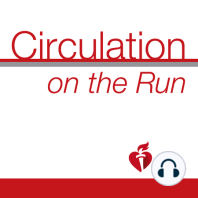18 min listen
Circulation July 20, 2021 Issue
ratings:
Length:
19 minutes
Released:
Jul 19, 2021
Format:
Podcast episode
Description
This week's episode features author Kieran Docherty and Associate Editor Torbjørn Omland as they discuss the article "The Effect of Neprilysin Inhibition on Left Ventricular Remodeling in Patients with Asymptomatic Left Ventricular Systolic Dysfunction Late After Myocardial Infarction." Dr. Carolyn Lam: Welcome to Circulation on the Run, your weekly podcast, summary, and backstage pass to the journal and its editors. We're your co-hosts: I'm Dr. Carolyn Lam, associate editor from the National Heart Center and Duke National University of Singapore. Dr. Greg Hundley: And I'm Dr. Greg Hundley, associate, editor, director of the Pauley Heart Center at VCU Health in Richmond, Virginia. Well, Carolyn, we've got an exciting feature this week involving Neprilysin license inhibition and left ventricular remodeling in patients with asymptomatic left ventricular systolic function after they've sustained myocardial infarction. But before we get to that feature discussion, how about we grab a cup of coffee and jump in on some of the other articles in the issue? Would you like to go first? Dr. Carolyn Lam: I'd love to, and I want to talk about transcatheter aortic valve replacement, or TAVR, that we all know is really transforming our management of aortic stenosis. Despite rapid improvements, however, serious complications remain relatively common and are not well-described by single outcome measures. So the purpose of this paper was to determine if there was site-level variation in TAVR outcomes in the United States using a novel 30-day composite measure. And this is from Dr. Desai and colleagues from Hospital of University of Pennsylvania. So they performed a retrospective cohort study using data from the STS/ACC TVT registry to develop a novel-ranked competent performance measure that incorporates mortality and serious complications. Based on the associations with one-year risk adjusted mortality and health status, they identified for peri-procedural complications to include in the composite risk model, in addition to mortality. And ranked empirically, according to severity, these were: stroke, major life-threatening or disabling bleeding, stage three acute kidney injury, and moderate or severe perivalvular regurgitation. Dr. Carolyn Lam: Now, based on these ranked outcomes, they found that there was significant site-level variation in quality of care in TAVR in the United States. Overall, better-than-expected site performance was observed in 8% of sites, whereas performance as-expected was observed in 80%, and worse-than-expected performance was observed in 11% of sites. Dr. Greg Hundley: Carolyn, really interesting comprehensive data. So how do we put this all together? And what's the take-home message for us, clinically? Dr. Carolyn Lam: Well, there are substantial variations in the quality of TAVR care received in the United States, and 11% of sites were identified as providing care below the average level of performance. Further study is necessary to determine the structural, process-related, and technical factors associated with high- and low-performing sites. And all this is discussed in a beautifully, beautiful accompanying editorial by Drs. Dharam Kumbhani and Eric Peterson. Dr. Greg Hundley: Oh, fantastic. You know, Carolyn, those editorials are so helpful in helping us put these new data in perspective. Well, my next paper comes to us from the world of preclinical science, and it's from Professor Vincent Christoffels from Amsterdam in UMC. So genetic variants of SCN10A, encoding the neural voltage-gated sodium channel NaV1.8 are strongly associated with atrial fibrillation, Brugada syndrome, cardiac conduction velocities, and heart rate. And these investigators studied the cardiac expression of SCN10A and the function of a variant-sensitive intronic enhancer previously linked to the regulation of SCN5A, and coding the major essential cardiac sodium channel NaV1.5. Dr. Carolyn Lam: Wow, great. So what did they find, Greg? Sou
Released:
Jul 19, 2021
Format:
Podcast episode
Titles in the series (100)
Circulation January 23, 2018 Issue by Circulation on the Run
